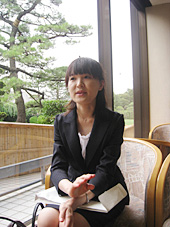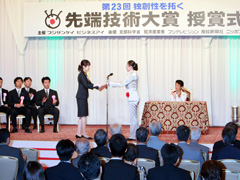Top>Hakumon CHUO>Rika Mochizuki (alumna of the Graduate School of Science and Engineering) receives Award of the Minister of Education, Culture, Sports, Science and Technology. 23rd Advanced Technology Award presented for "Research in Methods for Correcting Color Weakness."
 Index
Index
News Plus
Rika Mochizuki (alumna of the Graduate School of Science and Engineering) receives Award of the Minister of Education, Culture, Sports, Science and Technology.
23rd Advanced Technology Award presented for Research in Methods for Correcting Color Weakness.

Ms. Rika Mochizuki
Ms. Rika Mochizuki, who finished the Master's Program in Information and Systems Engineering in 2008 at the Chuo University Graduate School of Science and Engineering, was presented with the 23rd Refined Creativity-Advanced Technology Award (sponsored by Fuji-Sankei Business Eye; support given by the Sankei Newspaper). The award is given by the Minister of Education, Culture Sports, Science and Technology (MEXT) in order to honor science and engineering students and young corporate researchers who have achieved outstanding research success in advanced technological fields. The award ceremony was held on July 23rd at the former Meiji Memorial Hall in Akasaka, Tokyo, and featured attendance by Prince Takamado Nomiya. Ms. Mochizuki was presented with the award from Ms. Tomoko Ukishima, Parliamentary Secretary of the MEXT (at that time).
The Advanced Technology Award was established in 1987 in order to develop creativity in young researchers and to assist in realizing the status of a leading country in scientific technology. For the 23rd award, there were 32 entries in the student division and 36 entries in the corporate division. As a result of judging these entries (Chairman: Professor Emeritus Hiroyuki Abe of Tohoku University), Ms. Mochizuki's research in methods for correcting color weakness was selected for the Award of the Minister of Education, Culture, Sports, Science and Technology, which was the grand prize for the student division. Ms. Mochizuki's method utilizes color correction technology and can be applied to color-blind individuals.
◊ ◊
Consider the colors within our field of vision that we casually view every day. It is not possible for anyone to confirm how those colors are seen by another person. Furthermore, in the case of color-blind individuals, it is not understood how a certain color is seen, or how the perception of colors differs from individuals with normal eyesight.
Ms. Mochizuki focused on this point and quantified the perception of colors. She also specifically expressed the differences in color perception between color-blind individuals and individuals with normal eyesight. Then, by performing correction, she developed a new method that enables color-blind individuals to perceive color similar to the perception of individuals with normal eyesight.
Ms. Mochizuki's research was discovered by fusing 3 completely different fields. These fields consisted of 1) the artistic perspective of color classification, 2) the medical perspective of a new treatment (correction) method for color-blind individuals, and a mathematical perspective that gave form to human perception through the use of Riemann geometry. The research was evaluated as "aggressive research based on new ways of thinking."
◊ ◊
Ms. Mochizuki learned that she had received the award when she read a cellular phone email sent by her mother. "I applied as a sort of 'commemoration" of my graduation, so I was truly surprised when I heard that I had received the award. However, I was already employed at the time and I went to work the next day after receiving the award, I didn't have a real sense of what I had accomplished." The research thesis which received the award was written by Ms. Mochizuki when she graduated from her second year of the Master's Program. Therefore, she has been employed at a corporate research center since spring of this year.

During a ceremony attended by Prince Takamado Nomiya, Ms. Rika Mochizuki receives the Award of the Minister of Education, Culture, Sports, Science and Technology (photograph provided by the Sankei Newspaper)
Ms. Mochizuki has also been interested in mathematics and has enjoyed paintings and other forms of art. She was pondering what could be accomplished by combining these two completely different fields, and the content of her research came into form during discussions with her instructor Professor Jinhui Chao.
"Professor Chao has a very enjoyable and refreshing way of considering matters. When I reached a standstill in my research and went to consult him, Professor Chao would also think in a very enjoyable way direction. I had many discussions with him regarding my research."
Ms. Mochizuki says that the most difficult part of her research was the great amount of time required to conduct a single experiment. "For a single person, approximately 2 hours are required to perform an experiment regarding one color. However, breaks are also necessary, and data cannot be used until the person participating in the experiment has adjusted to the method being used. Therefore, more than 4 hours were actually required."
Professor Chao praised Ms. Mochizuki by saying that "she was very patient in how she continued to conduct experiments." Ms. Mochizuki offered the following analysis of herself: "I tend to become absorbed in things. I enjoy constantly thinking about a certain matter, and I am skilled at that way of thinking."
After the awards ceremony, panels of the award recipients were exhibited at a reception venue. It was possible to freely discuss the content of research with award recipients. A crowd of people was constantly gathered in front of Ms. Mochizuki's panel.
"The most frequently asked question was what colors are actually difficult for color-blind individuals to perceive. I was also asked questions regarding the practical application of my research, and there were also people who expressed interest in the ability to understand the color perception of individuals."
Ms. Mochizuki expressed her focus on the future as follows: "Until now, I have performed research regarding color. Even as I continue to conduct such research, I want to study color from a variety of perspectives in order to become an expert. I would like to become a person who is the master of a certain field."
In addition to her full-time employment, Ms. Mochizuki returned to Chuo University in September in order to pursue her Doctoral Degree. "I intend to continue my research at the university by finding time on Saturdays and during other non-busy periods." She expressed desire towards her future research activities by stating "there are still many things that I have left unaccomplished."
(Student Reporter: Naomi Hashimoto, 2nd Year Master's Student at the Graduate School of Science and Engineering)
- Research Activities as a Member of Research Fellowship for Young Scientists (DC1), Japan Society for the Promotion of Science (JSPS) Shuma Tsurumi
- Important Factors for Innovation in Payment Services Nobuhiko Sugiura
- Beyond the Concepts of Fellow Citizens and Foreigners— To Achieve SDGs Goal 10 “Reduce Inequality Within and Among Countries” Rika Lee
- Diary of Struggles in Cambodia Fumie Fukuoka
- How Can We Measure Learning Ability?
—Analysis of a Competency Self-Assessment Questionnaire— Yu Saito / Yoko Neha - The Making of the Movie Kirakira Megane








